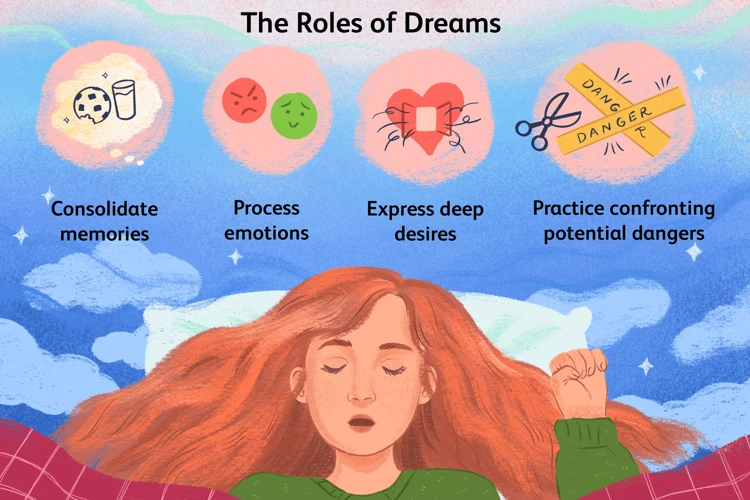Have you ever experienced the terror of a nightmare that keeps you awake at night? As sleep is meant to be a peaceful and rejuvenating time, nightmares can be incredibly disruptive to our overall well-being. However, there may be a fascinating solution to this age-old problem: lucid dreaming. Lucid dreaming allows individuals to become aware that they are dreaming while still in the midst of a dream, giving them the power to actively participate in and control their own dream experiences. And interestingly enough, lucid dreaming has shown promising potential in alleviating nightmares and improving the quality of sleep. In this article, we delve into the realm of lucid dreaming and explore how it may be a possible solution for those plagued by nightmares, providing a step-by-step guide to help you harness this incredible phenomenon. So, let’s embark on this journey of understanding and unlock the incredible power of lucid dreaming.
Understanding Nightmares

Nightmares are more than just bad dreams; they can be intense and frightening experiences that leave individuals feeling distressed long after waking up. Understanding the causes of nightmares can help shed light on why they occur. While nightmares can stem from various factors such as stress, trauma, medications, or certain sleep disorders, their root cause can often be linked to unresolved emotions or subconscious fears. They can serve as manifestations of our inner conflicts or anxieties, acting as an outlet for processing emotions we may not be consciously aware of. It’s essential to note that nightmares can have different meanings for different individuals, as they are deeply personal experiences. For some, recurring nightmares may be a signal that something in their life needs addressing, while for others, they may be linked to specific events or traumas. Exploring the psychological interpretation of nightmares can offer valuable insights into their significance and help individuals gain a better understanding of their own subconscious minds. (source: psychological interpretation of recurring nightmares)
Definition and Causes
Definition and Causes of Nightmares
Nightmares are vivid and disturbing dreams that can elicit feelings of fear, anxiety, and terror. They often occur during the rapid eye movement (REM) stage of sleep, which is when most dreaming takes place. Unlike regular dreams, nightmares are characterized by their intense and emotionally charged content. They can involve scenarios of danger, threat, or helplessness, which can leave individuals feeling overwhelmed upon waking up. Nightmares can differ in intensity and frequency from person to person.
The causes of nightmares can vary and may be a result of both internal and external factors. Internally, nightmares can be attributed to psychological factors such as stress, anxiety, trauma, or emotional conflicts. For example, individuals who have experienced a traumatic event might have recurring nightmares as a way for their minds to process and cope with the trauma. In some cases, nightmares can also be linked to mental health disorders such as post-traumatic stress disorder (PTSD) or anxiety disorders. External factors that can contribute to nightmares include certain medications, substance abuse, sleep deprivation, or disrupted sleep patterns.
Children are particularly susceptible to nightmares, and the causes may differ from those in adults. Nightmares in children can be influenced by a variety of factors, including developmental stages, fears, anxieties, or exposure to scary or violent media. Understanding the causes and triggers of nightmares in children is essential for parents and caregivers to provide the necessary support and coping strategies. (source: nightmares in children: causes, effects, coping strategies)
It’s also worth noting that nightmares can sometimes contain common themes or symbols that hold personal meaning to the individual. Analyzing these themes and symbols may offer a deeper understanding of the underlying emotions and concerns that the nightmares represent. (source: common themes and symbols in nightmares) By exploring the causes and potential meanings of nightmares, individuals can begin to address and find ways to mitigate the impact of these unsettling dreams.
The Impact on Sleep
– Disrupted Sleep Cycles: Nightmares can significantly disrupt the normal sleep cycles, particularly during the REM (rapid eye movement) stage. During REM sleep, which is associated with vivid dreaming, nightmares can cause frequent awakenings, leading to fragmented sleep and decreased overall sleep quality.
– Increased Sleep Disruptions: The occurrence of nightmares can lead to increased night awakenings, making it harder to fall back asleep. This can result in reduced total sleep time and may contribute to sleep deprivation over time.
– Poor Sleep Quality: Nightmares can trigger heightened arousal, increased heart rate, and feelings of anxiety and fear during sleep. As a result, individuals may experience poor sleep quality, feeling unrested and fatigued upon waking.
– Emotional Distress: The emotional impact of nightmares can have lingering effects on sleep. Intense emotions such as fear, sadness, or helplessness can persist even after waking up, making it difficult for individuals to relax and fall back asleep.
– Daytime Fatigue: The disruptive nature of nightmares can lead to daytime fatigue and drowsiness. Regularly experiencing nightmares can leave individuals feeling exhausted and less alert during the daytime, impacting their overall productivity and quality of life.
It is important to address the impact of nightmares on sleep as it highlights the significance of finding effective solutions to alleviate these distressing experiences.
What is Lucid Dreaming?

Lucid dreaming is a fascinating phenomenon that occurs during sleep when individuals become aware that they are dreaming and can actively participate in and manipulate the contents of their dreams. This heightened state of self-awareness allows individuals to consciously control their actions, surroundings, and even the outcomes of their dreams. In a lucid dream, individuals may possess a sense of freedom and agency as they navigate through their dream world. This extraordinary experience is characterized by a few distinct characteristics, including the ability to recognize the dream state while still asleep, the capacity to think with clarity and logic within the dream, as well as the ability to exert control over the dream environment and dream narrative. While lucid dreaming can occur spontaneously, there are various techniques and practices that individuals can employ to increase the likelihood of having lucid dreams. These methods range from reality checks and induction techniques to maintaining a dream journal to enhance dream recall and self-awareness. Lucid dreaming offers a unique opportunity to explore the depths of our subconscious minds and unlock the potential for incredible dream adventures.
Definition and Characteristics
Lucid dreaming is a unique state of consciousness where an individual becomes aware that they are dreaming while still in the dream itself. This awareness grants the dreamer the ability to actively participate in and manipulate the dream environment and storyline. Unlike regular dreams where the dreamer is often passive or unaware, lucid dreaming offers a sense of control and agency within the dream world. In a lucid dream, individuals can make conscious choices, interact with dream characters, change the dream scenery, and even engage in activities that would be impossible or difficult to achieve in waking life.
Characteristics of lucid dreams include vividness, clarity, and a heightened sense of realism. While ordinary dreams often seem fuzzy or hazy when recalled, lucid dreams are described as being incredibly vivid and lifelike, almost indistinguishable from waking reality. The dreamer may perceive sensory details with great clarity, such as the feel of objects, the taste of food, or the warmth of sunlight. Additionally, time perception may be altered during lucid dreams, with dreamers sometimes reporting that their lucid experiences feel more extended than their actual duration.
Another distinguishing characteristic of lucid dreaming is the presence of self-awareness. In a lucid dream, individuals have a clear understanding that they are dreaming and can distinguish between the dream world and the waking world. This self-awareness allows the dreamer to recognize the dream as a construct of their own mind, providing them with the freedom to explore, experiment, and navigate within the dream with a heightened level of consciousness.
Lucid dreaming can be seen as a fascinating phenomenon that bridges the gap between the dream realm and waking reality, offering individuals a unique opportunity to explore and engage with their subconscious mind in a conscious and deliberate manner.
How it Works
Lucid dreaming is a fascinating phenomenon that occurs during the rapid eye movement (REM) sleep stage. During this stage, the brain becomes highly active, and dreams occur. In traditional dreaming, individuals may not be aware that they are in a dream and tend to passively experience the events. However, in a lucid dream, individuals possess a heightened level of self-awareness and consciousness, allowing them to actively engage with the dream world.
The process of achieving lucidity in dreams involves developing the ability to recognize the dream state while still in the midst of dreaming. This newfound awareness opens up a world of possibilities for dream control and manipulation. One common approach is to perform reality checks throughout the day, which involves questioning one’s reality and determining whether one is awake or dreaming. By repeatedly practicing reality checks, individuals can train their minds to incorporate this habit into their dream state.
Once within a lucid dream, there are numerous techniques to enhance the level of control and interactivity. These techniques may include visualization, where individuals consciously imagine specific scenarios or outcomes within the dream, or practicing dream control, such as altering the dream environment or summoning specific characters or objects. By mastering these techniques, individuals can transform nightmares into more positive or even enjoyable dream experiences.
It is important to note that the process of achieving lucid dreams may vary from person to person, and it often requires patience and practice. Some individuals may naturally experience spontaneous lucidity in dreams, while others may need to actively cultivate the skill through methods such as meditation, reality checks, or the use of lucid dreaming induction techniques. With time and dedication, one can develop the ability to enter lucid dreams more frequently and enjoy the benefits they offer.
Lucid Dreaming and Nightmares

Lucid dreaming, the experience of being aware that one is dreaming during sleep, has shown promising potential in addressing nightmares. When it comes to nightmares, the ability to engage in lucid dreaming can have several benefits. Firstly, being aware that one is in a dream can provide a sense of control and empowerment, allowing individuals to actively change the course of the dream and mitigate the feelings of fear or distress. This can provide a tremendous relief, as it shifts the perspective from being a helpless victim of the nightmare to an active participant who can influence the dream narrative. Secondly, lucid dreaming offers an opportunity for individuals to confront and process their fears within the safety of a dream environment. By deliberately engaging with the content of the nightmares, individuals can gain insights, work through emotional issues, and potentially overcome recurring nightmares. Techniques such as reality checks, dream journaling, and intention setting can help induce and enhance lucid dreaming experiences, effectively turning nightmares into a platform for personal growth and resolution.
The Potential Benefits
The potential benefits of lucid dreaming for nightmares are truly remarkable. When individuals are able to become aware and have control over their dreams, they can actively intervene and modify the dream scenario to their liking. This newfound control empowers individuals to confront their fears, transform negative elements into positive ones, and even change the dream narrative altogether. By transforming the content and outcome of their nightmares, lucid dreamers can experience a sense of mastery over their fears and anxieties, leading to reduced distress and emotional healing. Lucid dreaming can also provide a safe space for individuals to practice coping strategies and rehearse positive outcomes in challenging situations. The ability to engage in lucid dreaming can enhance sleep quality by reducing the frequency and intensity of nightmares, allowing for a more restful and rejuvenating night’s sleep. It is important to note that while the potential benefits of lucid dreaming are promising, it may require practice and patience to develop the skills necessary to induce and maintain lucidity during dreams. However, the rewards of conquering nightmares and harnessing the power of lucid dreaming are well worth the effort.
Techniques to Induce Lucid Dreams
To experience lucid dreaming and potentially alleviate nightmares, it is crucial to employ specific techniques that can help induce these extraordinary dream states. Here are several proven methods to increase the likelihood of having lucid dreams:
1. Reality Checks: Performing reality checks throughout the day can train your mind to question the reality around you, which can carry over to your dreams. Reality checks involve examining your surroundings, looking at your hands, and questioning if you are dreaming. By making this a habit, you are more likely to perform the same checks within your dreams, leading to lucidity.
2. Mnemonic Induction of Lucid Dreams (MILD): This technique involves setting intentions before sleep by repeating affirmations such as, “Tonight, I will realize I am dreaming.” By continuously affirming your desire for lucidity, you create a subconscious focus that can increase the chances of becoming aware within your dreams.
3. Wake-Back-to-Bed (WBTB): This technique involves waking up after a few hours of sleep, staying awake for a short period, and then returning to sleep. This method capitalizes on the heightened dream recall and increased awareness during the wakeful period, making it easier to recognize and enter a lucid dream state upon falling back asleep.
4. Visualization: Before falling asleep, visualize your desired dream scenario vividly. This practice can enhance your dream recall and focus, making it more likely to recognize when you are dreaming.
5. Sleep Hygiene: Maintaining good sleep hygiene practices, such as sticking to a consistent sleep schedule, creating a calm sleep environment, and reducing exposure to screens before bed, can enhance the quality of your sleep and increase the likelihood of having vivid and lucid dreams.
It is essential to remember that lucid dreaming techniques require patience and practice. Finding the most effective method(s) for inducing lucid dreams may vary from person to person. Experimentation and perseverance are key to discovering what works best for you. With dedication and a little bit of luck, you can unlock the incredible world of lucid dreaming and potentially find relief from nightmares.
Scientific Research and Studies

Scientific research and studies have begun to shed light on the potential benefits of lucid dreaming in addressing nightmares. While the field of lucid dreaming is still relatively new, several studies have shown promising results. For example, a study published in the Journal of Consulting and Clinical Psychology found that individuals who practiced lucid dream induction techniques experienced a reduction in nightmare frequency and intensity. Additionally, research conducted by the University of Basel in Switzerland revealed that lucid dreaming can be an effective tool in treating post-traumatic stress disorder (PTSD) and recurring nightmares associated with trauma. These studies suggest that lucid dreaming may offer a unique therapeutic approach for individuals struggling with nightmares, providing a glimpse of hope for those who have long been plagued by these distressing dreams. However, it is important to note that more research is still needed to fully understand the mechanisms and potential limitations of lucid dreaming in addressing nightmares. Nonetheless, these studies provide encouraging evidence of the power of lucid dreaming as a possible solution for those seeking relief from the torment of nightmares.
Evidence Supporting Lucid Dreaming for Nightmares
Evidence Supporting Lucid Dreaming for Nightmares:
1. Research studies have shown that lucid dreaming can be an effective tool in reducing the frequency and intensity of nightmares. A study published in the journal “Dreaming” found that individuals who actively engaged in lucid dreaming techniques reported a significant decrease in the occurrence of nightmares compared to a control group.
2. By gaining control over their dreams, individuals are able to confront and overcome the fears that often fuel nightmares. Lucid dreaming provides a safe and controlled environment where individuals can actively participate in their dreams, altering the dream scenario, and transforming the terrifying elements into more positive or neutral experiences.
3. One technique used in lucid dreaming for nightmares is “dream rewriting”, where individuals intentionally change the course of the dream narrative to create a more positive outcome. This can involve visualizing a different ending, altering the behavior of the dream characters, or introducing elements that counteract the fear-inducing aspects of the nightmare.
4. Another method is the “fear confrontation” technique, where individuals intentionally engage with the source of their fear within the dream. By confronting the fear head-on, individuals can desensitize themselves to the nightmare scenario, leading to a reduction in fear response and subsequent nightmares.
5. A review article published in the journal “Sleep and Hypnosis” examined multiple studies on lucid dreaming for nightmares and concluded that lucid dreaming interventions showed promise in reducing nightmare frequency and improving sleep quality. However, it also highlighted the need for further research to better understand the mechanisms behind lucid dreaming and its impact on nightmares.
The evidence supporting lucid dreaming for nightmares suggests that this practice can be a valuable tool in alleviating the distress caused by recurring nightmares. Through the techniques of dream rewriting and fear confrontation, individuals can actively engage in their dream world, transforming nightmares into more positive or manageable experiences. While more research is needed, lucid dreaming shows promise as a potential solution for individuals struggling with the disruptive effects of nightmares on their sleep and overall well-being.
Limitations and Further Research
While lucid dreaming shows promise as a potential solution for nightmares, it is important to recognize its limitations and the need for further research in this area. One limitation is the difficulty in accurately measuring and studying lucid dreaming experiences. Since lucid dreaming occurs during the REM (Rapid Eye Movement) stage of sleep, which is associated with vivid dreams, distinguishing between regular dreams and lucid dreams can be challenging. This can make it difficult to gather reliable data and draw definitive conclusions about the effectiveness of lucid dreaming for nightmares. Additionally, the techniques used to induce lucid dreams vary in their success rates, and not everyone may be able to achieve lucidity consistently. The impact of long-term lucid dreaming practice on mental and physical health is still not well understood. It is crucial for further research to examine potential side effects or limitations of using lucid dreaming as a treatment for nightmares. Despite these limitations, ongoing research is exploring various approaches and technologies to enhance the induction and control of lucid dreams. As scientists continue to study the intricacies of lucid dreaming, we can hope for advancements that will improve our understanding and unlock its full potential for addressing nightmares and improving overall sleep quality.
Practical Tips for Lucid Dreaming
Embarking on a journey of lucid dreaming requires practice, patience, and a few practical tips to increase your chances of success. Keeping a dream journal is a valuable tool that can help you become more aware of your dreams, recognize patterns, and improve dream recall. By recording your dreams immediately upon waking, you can better identify dream signs that may trigger lucidity. Another technique is performing reality checks and induction methods throughout the day. This involves questioning your reality by examining your surroundings and asking yourself if you are dreaming. By repeating this habit, you may carry this habit into your dreams, thus triggering lucidity. Additionally, maintaining good sleep hygiene is crucial for enhancing dream quality and promoting lucid dreaming. Ensure you have a comfortable sleep environment, follow a consistent sleep schedule, and avoid stimulating activities before bed. Adopting these practical tips can improve your chances of experiencing lucid dreams and reaping the benefits they offer in terms of overcoming nightmares and exploring the boundless possibilities of your subconscious mind.
Keeping a Dream Journal
Keeping a dream journal is an essential practice when it comes to lucid dreaming. It involves recording your dreams immediately upon waking up, capturing as many details as possible. A dream journal serves as a valuable tool for improving dream recall and increasing self-awareness within dreams, which are vital for achieving lucidity. Here are some tips to effectively keep a dream journal:
1. Keep a journal by your bedside: Place a journal and pen next to your bed to ensure easy access as soon as you wake up. Keeping them within reach will help minimize the chance of forgetting your dreams.
2. Write immediately: As soon as you wake up, write down everything you remember about your dream. Even fragments or vague details can be valuable later on. Don’t worry about writing in full sentences; focus on capturing the essence of the dream.
3. Include sensory details: Pay attention to the sights, sounds, smells, tastes, and physical sensations experienced in the dream. These details can help create a rich account and make the dream more vivid when revisited.
4. Date each entry: Make sure to date each entry in your dream journal. This can help identify patterns, themes, or recurring elements in your dreams over time.
5. Review and reflect: Regularly review your dream journal entries. Look for common themes, symbols, or emotions that may occur in your dreams. This reflection can help you become more aware of your dream patterns and increase the likelihood of recognizing these patterns during future dreams.
6. Use sketches or diagrams: If you find it challenging to express certain dream elements in words, consider using visual aids like sketches or diagrams to represent the dream imagery.
7. Be consistent: Make a habit of recording your dreams every morning, even if you don’t remember much at first. With practice, dream recall will improve, and you’ll be able to document more detailed dreams.
Keeping a dream journal is a powerful technique that can enhance your dream recall and increase lucid dream potential. It allows you to track your progress, identify patterns, and gain valuable insights into your dream world. So grab a journal, start recording your dreams, and unlock the doorway to lucidity!
Reality Checks and Induction Methods
Reality checks and induction methods are vital techniques for individuals looking to actively induce lucid dreams and take control of their dream experiences. Reality checks involve performing simple tasks or observations throughout the day to determine whether you are in a dream or in reality. By incorporating these reality checks into your daily routine, you can train your mind to question the nature of your surroundings in your dreams. Some common reality checks include looking at your hands and observing if they appear distorted or counting your fingers to see if the number matches the reality. Another popular reality check is attempting to read a piece of text or the time on a clock, as dream text and numbers often appear scrambled or constantly changing. By consistently performing these reality checks in waking life, you develop the habit of questioning reality, which carries over into your dreams.
In addition to reality checks, there are various induction methods that can increase your likelihood of experiencing lucid dreams. One popular method is called the Mnemonic Induction of Lucid Dreams (MILD). This involves setting an intention to remember that you are dreaming before you fall asleep. As you lay in bed, repeat a phrase like “I will have a lucid dream tonight” and visualize yourself becoming lucid in a dream scenario. This repetition and visualization help to strengthen the intention and increase the chances of achieving lucidity during sleep.
Another technique is the Wake-Back-to-Bed (WBTB) method. This involves setting an alarm to wake yourself up after a few hours of sleep and then engaging in some wakeful activities for a short period. This could include reading about lucid dreaming, practicing relaxation exercises, or jotting down any dream fragments you can recall. Following the wakeful period, return to bed with the intention of having a lucid dream. The combination of waking up from deep sleep and returning to REM sleep can enhance the likelihood of experiencing lucidity.
These reality checks and induction methods require consistency and practice. It may take time to develop the habit of performing reality checks and to increase self-awareness within dreams. However, with perseverance and a genuine desire to explore the world of lucid dreaming, these techniques can become powerful tools for transforming your nightmares into empowering and enjoyable dream experiences.
Maintaining Sleep Hygiene
Maintaining proper sleep hygiene is crucial for enhancing the chances of experiencing lucid dreams and improving overall sleep quality. Here are some essential tips to incorporate into your routine:
1. Create a Restful Environment: Ensure that your bedroom is conducive to sleep. Keep the room dark, quiet, and at a comfortable temperature. Use earplugs or a white noise machine if needed.
2. Stick to a Consistent Sleep Schedule: Try to go to bed and wake up at the same time every day, even on weekends. This helps regulate your body’s internal clock and promotes better sleep.
3. Limit Electronic Devices: Avoid using electronic devices such as smartphones, tablets, or laptops before bed. The blue light emitted by these devices can interfere with the sleep hormone melatonin, making it harder to fall asleep.
4. Avoid Stimulants: Limit your intake of caffeine, nicotine, and alcohol, especially in the hours leading up to bedtime. These substances can disrupt sleep patterns and make it difficult to achieve a peaceful state of mind.
5. Establish a Bedtime Routine: Engage in relaxing activities before bed, such as reading a book, practicing meditation or deep breathing exercises, or taking a warm bath. This signals to your body that it’s time to unwind and prepare for sleep.
6. Make Your Bedroom a Dream-Friendly Space: Surround yourself with images, objects, or scents that evoke positive emotions or relaxation. This can help foster a peaceful and serene atmosphere, promoting a greater likelihood of lucid dreaming.
7. Consider Sleep Supplements: Consult with a healthcare professional about the potential benefits of natural sleep aids, such as herbal teas, melatonin supplements, or aromatherapy to enhance your sleep quality.
By maintaining good sleep hygiene, you can create a favorable environment for practicing lucid dreaming techniques and increasing the likelihood of having vivid and controlled dreams. Remember that cultivating healthy sleep habits requires consistency and patience, but the rewards can be well worth the effort.
Conclusion
In conclusion, lucid dreaming presents a fascinating potential solution for nightmares, offering individuals the opportunity to take control of their dream experiences and transform frightening scenarios into empowering ones. Through lucid dreaming, individuals can actively confront their fears, work through unresolved emotions, and even reshape the outcomes of their dreams. While the scientific research on lucid dreaming’s effectiveness in reducing nightmares is still developing, there is evidence to suggest its potential benefits. Techniques such as keeping a dream journal, practicing reality checks, and maintaining good sleep hygiene can greatly enhance the chances of achieving lucid dreams. However, it is important to note that lucid dreaming is not a guaranteed solution for everyone, and further research is needed to fully understand its limitations and effectiveness. Nevertheless, for those who are open to exploring the realm of lucid dreaming, it holds promise as a tool for transforming nightmares into opportunities for growth and self-discovery. So, if you are plagued by nightmares and seek alternative methods to combat them, why not embark on this incredible journey of lucid dreaming and unlock the power of your own subconscious mind?
Frequently Asked Questions
What are some common themes and symbols in nightmares?
Nightmares can vary in content and symbolism, but some common themes include falling, being chased, being trapped, or experiencing physical harm. Symbols such as snakes, spiders, or dark figures can also appear in nightmares, often representing fear or anxiety.
Can nightmares be a sign of an underlying sleep disorder?
Yes, nightmares can sometimes be a symptom of sleep disorders such as sleep apnea, restless legs syndrome, or narcolepsy. Consulting a healthcare professional can help determine if there is an underlying sleep issue contributing to the nightmares.
Is it normal for children to have nightmares?
Yes, nightmares are common among children, particularly during periods of development or when they are processing new and challenging experiences. Providing comfort and reassurance can help children cope with and overcome their nightmares.
Can medications or substances contribute to nightmares?
Yes, certain medications, such as antidepressants or blood pressure medications, have been known to cause vivid dreams or nightmares as a side effect. Similarly, substances like alcohol or illicit drugs can disrupt sleep and contribute to nightmares.
Can lucid dreaming be used as a treatment for nightmares?
Yes, lucid dreaming has shown promise in alleviating nightmares. Becoming aware that one is dreaming during a nightmare can empower individuals to take control of the dream scenario and change it in a positive direction.
Are there any techniques to induce lucid dreams?
Yes, techniques such as reality checks, keeping a dream journal, and practicing meditation before sleep can increase the likelihood of inducing lucid dreams. These techniques help build a stronger connection between the waking and dreaming states of consciousness.
Can lucid dreaming have any negative effects?
In general, lucid dreaming is considered safe and does not have any negative effects. However, some individuals may experience temporary sleep disturbances or difficulties distinguishing between dreams and reality during the waking state.
Is there scientific research supporting the benefits of lucid dreaming?
Yes, numerous studies have explored the potential benefits of lucid dreaming, including its positive impact on reducing nightmares, improving problem-solving skills, and enhancing creativity. However, further research is still needed to fully understand its mechanisms and potential applications.
How long does it typically take to learn how to have lucid dreams?
Learning to have lucid dreams can vary from person to person. Some individuals may have their first lucid dream within a few weeks of practice, while others may take several months. Consistency and patience are key in developing the skill of lucid dreaming.
Can lucid dreaming be used for purposes other than nightmares?
Absolutely! Lucid dreaming can be used for various purposes, such as exploring creativity, problem-solving, personal growth, or simply enjoying unique and immersive dream experiences. Its potential applications extend far beyond alleviating nightmares.








